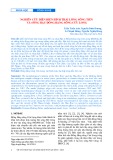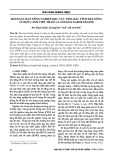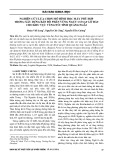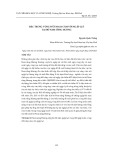
VNU Journal of Science: Earth and Environmental Sciences, Vol. 41, No. 1 (2025) 47-53
47
Original Article
Application of Google Earth Engine to Estimate the Water
Capacity of Saigon–Dongnai Basin in the Period of
2005–2023 Using MODIS and CHIRPS Satellite Data
Le Trong Dieu Hien1,*, Do Xuan Hong2
1University of Thu Dau Mot, 6 Tran Van On, Thu Dau Mot City, Binh Duong, Vietnam
2Nong Lam University - Ho Chi Minh City, Linh Trung, Thu Duc, Ho Chi Minh City, Vietnam
Received 26th August 2024
Revised 18th October 2024; Accepted 6th February 2025
Abstract: This study used the Google Earth Engine (GEE) platform to calculate the water capacity
of the Saigon-Dongnai basin using remote sensing-derived products related to evapotranspiration
(ET) and precipitation (P). The GEE was used to retrieve two important inputs: MODIS
evapotranspiration spanning the drainage basin and CHIRPS satellite precipitation. We found that
there was a net decrease in the water capacity from January to April every year as a result of greater
evaporation and less precipitation. Due to the increase of precipitation from May to October
following the decrease of solar radiation, and the drop in temperature, the rainy season imposed the
highest values of the change in water capacity. Rainfall and evapotranspiration show a positive
association, as does the relationship between water capacity and inputting water.
Keywords: Water capacity, evapotranspiration, Google Earth Engine, CHIRPS, MODIS.
1. Introduction*
In river basins, water is essential for
industrial processes, power generation, food
security, and human survival. Water is essential
to both terrestrial and aquatic ecosystems in
order to deliver important ecosystem services for
present and future generations. Managing the
________
* Corresponding author.
E-mail address: hienltd@tdmu.edu.vn
https://doi.org/10.25073/2588-1094/vnuees.5215
complex water flow paths to and from these
various water-use industries necessitates a
quantitative grasp of hydrological processes. To
support water-use management more effectively
through retention, withdrawals, and changes in
water use, quantitative insights, background data
are required.






























